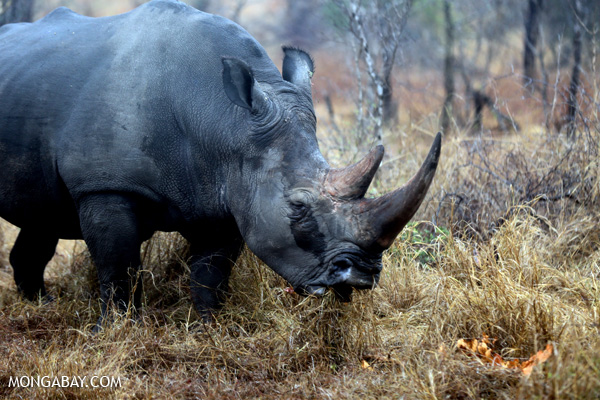
Rhino in South Africa. Photo by Rhett Butler.
Conservationists are successfully developing mobile apps that enable authorities to identify illegal wildlife products, making it more difficult for traffickers to smuggle animals and animal parts, reports a paper published in the journal Biological Conservation.
Researchers with the Wildlife Conservation Society present three case studies of apps being used to identify species and crack down on wildlife crime: Wildlife Guardian in China; giamdinhloai.vn in Vietnam; and Wildlife Alert, used by U.S. military police in Afghanistan. Each tool relies on a decision-tree approach where “the user inputs data and through a process of elimination, identifies or classifies the traded wildlife or wildlife products,” according to WCS.
The group notes that mobile apps offer advantages over traditional websites in that they are functional even without an Internet connection.
“Information on where illegal wildlife and wildlife products are sold or detected can then be shared with larger Wildlife Enforcement monitoring systems and help disrupt supply chains for transnational wildlife crime,” said study co-author Peter Zahler, WCS Asia Program Deputy Director, in a statement.
In China, the world’s largest market for wildlife products, Wildlife Guardian is being used by customs agents to identify animal products. The process involves a three-step species identification system. If that doesn’t confirm an animal’s identity, the app facilitates an expert-assisted identification process, where a scientist provides feedback in less than a day, according to WCS China’s Lishu Li, who wasn’t involved in the paper, but spoke about the tool in July at the annual meeting of the Association for Tropical Biology and Conservation in Cairns, Australia.
WCS reports that more than 1,100 people have downloaded the software, which is available for both Android and iOS devices.


Wildlife Alert App. Credit: Heidi Kretser/WCS
The platform in Vietnam uses a similar approach.
“The website includes step-by-step, visually-aided guidelines to help users identify 152 protected wildlife species in Vietnam and a number of commonly traded products taken from endangered wildlife such as rhino horn, elephant ivory and tiger body parts,” said WCS in a statement. “Access to instant online support is also provided.”
Wildlife Alert is currently under development and will soon be deployed in Afghanistan. While military personnel and contractors have often received basic information about illegal wildlife products, surveys indicate that purchases still occur regularly, suggesting that additional tools are needed to curb the practice.
CITATION: Heidi E. Kretser, Ramacandra Wong, Scott Roberton, Carrianne Pershyn, JianMing Huang, Fuping Sun, Aili Kang, and Peter Zahler. Mobile decision-tree tool technology as a means to detect wildlife crimes and build enforcement networks. Biological Conservation. DOI: 10.1016/j.biocon.2014.08.018